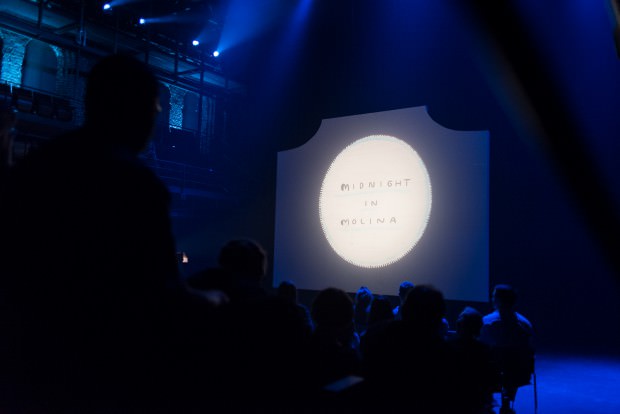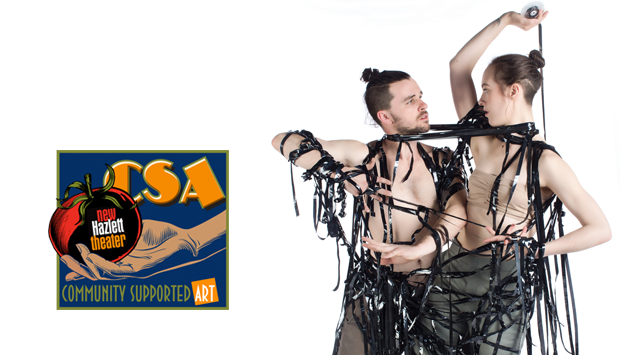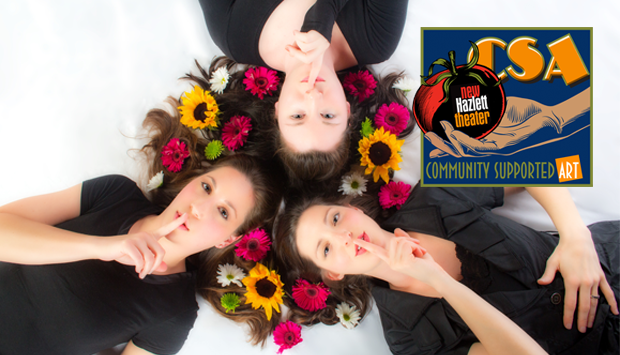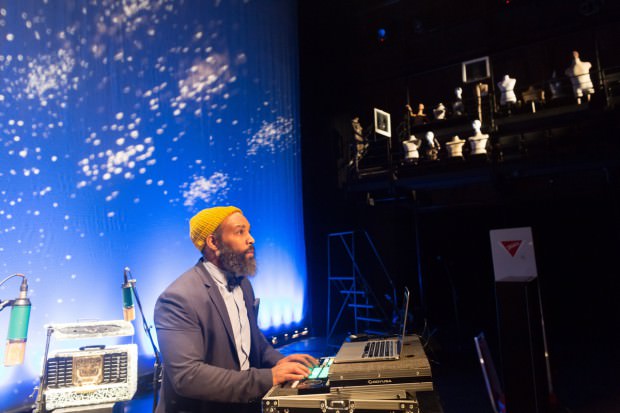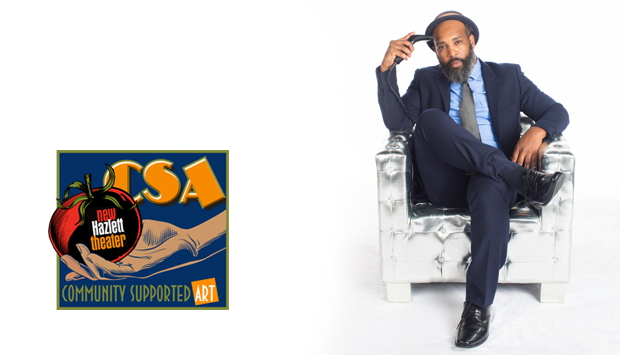Linda Kernohan sat down with Trillium Ensemble and composer Mark Fromm to talk about The Silent Spring Project.
Linda Kernohan: Let’s start by discussing the origins of the project. Trillium had recorded Mark’s music previously, but how did you develop the idea of incorporating it into this theatrical, multi-media experience?
Rachael Stutzman Cohen: Our relationship with Mark started when we commissioned his piece, Silent Spring. That led to our recording several of his pieces in June of 2014. During the recording process, we thought a lot about how related these pieces were, and how they could tell a larger story. Our sound engineer, Don Maue, really pushed us to develop something completely different and innovative, because who needs another CD of classical music, you know?
From there, it kept blossoming. Once we got the opportunity through the CSA with the New Hazlett, that’s when the project really took off, incorporating theatrical elements with our set designer and lighting designer. Those are people we wouldn’t normally be able to connect with.
Elise DePasquale: Even before we got the CSA, we were thinking about what we could tie in with a CD release. We were thinking of tying it in with a performance, but it would be boring to just play all the songs you’re going to hear on the CD. How could we have a CD release concert that is different from what’s on the CD? And that flowed really nicely into the opportunities the New Hazlett CSA gave us. They provided a pool of design artists for us to work with.
LK: Mark, the music for the project draws on your pre-existing pieces. Would you describe your process of adapting them for this production?
Mark Fromm: The piece Silent Spring is the focus, and it’s just played pretty much the way I originally intended it. The other piece that ties everything together uses Buckminster Fuller’s text as its inspiration. I feel like Rachel Carson and Buckminster Fuller have a lot in common in terms of looking towards the future, and trying to see what impact humans are having now and what we could do to make it better. Those ideas led me to take the other pieces I had and think about what mood they evoked and how I could tie that in to the story, using text from Fuller and Carson to speak over top of those pieces, so the music carries the emotion of the text.
LK: In this project, the members of the ensemble use an expanded concept of performing that goes beyond just playing your instrument, to include singing, speaking, and movement around the stage. What previous experience do you have with these other ways of performing?
RSC: As an ensemble, we’ve been trying to bring chamber music to our audiences in new ways. We don’t necessarily do a lot of speaking as characters on stage, but we do speak to the audience and engage them in other ways. That’s where most of my experience comes from. I haven’t really moved with my instrument since marching band in high school!
Katie Palumbo: I’ve had some musical theatre experience in the past that I’ve been able draw on. I’ve also done a lot of a cappella group singing, which I feel is similar in the way you have to put yourself out there.
LK: Do you mean the Glee style of a cappella singing, or more like classical choral?
KP: A little bit like Glee, yeah! I sang with an all-female a cappella group in college, performing pop music. But I feel like singing with flute and clarinet is like a small choir. Parts of Silent Spring feel very choral to me. I really love singing with them and being able to step away from the piano a little bit.
EDP: I’ve had a little experience outside of Trillium with some more experimental kinds of performances. I played in a performance that combined music with choreography, and I moved around and improvised. This performance involves moving around, but it’s planned, and you have to do it exactly right and not mess up! So there’s freedom, but there’s a lot of precision to it as well.
RSC: All the extramusical elements we’re incorporating — we’re not doing them just to do them. It’s all about bringing the music more into focus and making it a more meaningful experience, especially in terms of the movement. It’s not obscene amounts of movement; it’s a few visual changes, to bring the music physically closer to the audience.
KP: We started out with all these great ideas of being up in the rafters, and using the multiple levels that the New Hazlett Theater has. But we asked, what is the purpose of doing that? We really wanted the intention of the music to come out through the movement.
RSC: Everything we’re doing is designed to serve the music.
LK: How did the theatrical elements inform your playing, and vice versa — how did your previous experience of playing the music inform the theatrical elements?
RSC: For me personally, one thing that’s really different is standing to play my bass clarinet. Some people do that using a harness or neck strap, and I played around with that, but it was still very physically challenging. So our set designer created a little pedestal for my bass clarinet, so it’s still resting on the ground. I’m standing for the entire performance. That’s been an interesting learning experience; I’m much more aware of my body in a different way, and the response of the instrument to what I’m doing.
KP: We have costumes, which our set designer is doing. We originally had the idea of transforming the costumes, taking things off as we moved forward on stage. But we didn’t want it to become a striptease! So instead, we’re using lighting elements reflecting off of a white, lacy material. I think the lighting will enhance the performance of the pieces and change how we feel on stage.
We decided to take the piano lid off completely, because Rachael and Elise will be a little bit behind me for the majority of the show, and I need to have an eyeline with them. And we didn’t want the lid blocking the back of the stage. We start in the very back of the theater at the beginning of the performance. That’s going to be different for me.
In the first piece, there’s a pre-recorded track where the piano and percussion play, and I’m singing over top of that. It was a little weird not being at the piano. But it gives me freedom to move around, which I think will be really fun.
EDP: For me, I’m using the full range of flutes, compliments of the Flute Academy in Pittsburgh. I’m borrowing an alto flute, a bass flute, and a contrabass flute, which is two octaves lower. It stands up straight, and you stand to play it. It’s a big, booming, didgeridoo-sounding instrument. That will add a lot of new theatrical elements, just having these really big instruments and really low tones that I don’t normally get to enjoy, being the high-pitched flute player. So that’ll be really fun.
LK: You are all experts on your instruments, yet you gamely took on these additional modes of performance. What was most challenging about that for each of you?
EDP: Part of the reimagining of our recordings involves playing along with pre-recorded material. While brainstorming with our sound designers about how that would work, we decided we need to be in control of when the pre-recorded material happens. We’ll use a bluetooth foot pedal to trigger — we call them blobs, but you could call them tracks. I’m going to be the one doing that, and I’ve started practicing it. It will be very tricky to do it while I’m playing; I have to get used to about a half a second delay from when I hit the pedal to when the next track starts. You want it as seamless as possible. That will be my biggest challenge. The nice thing about live music is you can react to what others are doing, and obviously we love that part of it. One of the challenges of playing with the recording is, you’re a little more tied down. We still have some freedom because the recorded part is basically a vamp section. But that is something we have to get used to — the track is going to do what it’s going to do every time.
KP: One other challenging thing is, we’re farther apart on stage than we normally are. Normally we’re closer together and I can see both Rachael and Elise. But the beauty of it is, we know the pieces really, really well, and I think that’s going to come across by the way we’re configured. I like the idea of us traveling on stage. It gives the audience a different perspective on how the music sounds, as it comes closer to them. But it’s challenging for us to play that way.
LK: What was most rewarding?
RSC: Seeing the support we’re getting through our Kickstarter has been so gratifying and overwhelming. It’s just awesome to see all these people all over the country think, “Wow, that’s so cool, I really want you guys to succeed.” That part has been really great. I’m really excited to see how audience reacts, and then the students, when we do it again for them.
KP: It’s great just being able to branch out from the normal chamber music setting. The amazing support of the CSA, and the knowledge of people who’ve been working in the theater for a really long time, added to what we do, is just so different from what we’ve ever done. I think it’s going to help us grow so much as an ensemble, and as musicians. When you step outside the box like that, it makes everything else so much easier.
RSC: The other thing that’s been really fun is, the more you let your mind go in this creative direction, the more things you come up with. In some ways it’s hard to stay focused, because we have so much to accomplish for this concert to succeed the way we want it to. But we keep thinking about all these other things we want to do in the future. It’s so cool to see what is possible once you release your mind into that creative space.
MF: It’s been really great to explore ideas and allow them to come to fruition more than they would have otherwise. When I wrote Silent Spring, I had a very specific idea of what I want the music to say, and I just hoped the audience would get that. I never really know if they do. In this bigger context, with this interview in the program that the audience is going to read, with the talkback session, it’s not just like I wrote some notes on a page and now we’re listening to them. It’s a much bigger idea that’s taken on a much bigger meaning. At the performances I’ve been to at the New Hazlett, and the talkback sessions, the audience is really informed and engaged. I’m really excited about that part of it.
RSC: A lot of times as performers, we’re only talking to other musicians. I think as an ensemble part of our mission is to break down barriers and bring music to people. We want them to feel a part of the music, even if they didn’t go to music school, or play an instrument as a kid.
KP: It’s become a personal experience for me, too, and I think for all of us. Through this music I’ve been able to learn about Buckminster Fuller and Rachel Carson and their ideas, and how much I connect with those ideas and ideals and how much I want to share them with the world. As a kid, I always loved environmentalism and thought about how I could help the world, and “save the rain forests!” I think for all of us, it’s not just playing music, it’s the concepts behind the music that we’re trying to share with people.
RSC: There’s so much that is reality-based in where this music came from. Sometimes as a musician, I think you get sucked into your own little world. I’m sure it happens to people in every profession. You put on your blinders and it’s only music all the time. But that’s not how you connect to other people — you have to really experience the world and reflect on it to engage other people. That’s one thing I really like about this concert: it’s not just music for musicians — it comes from real ideas. I really think the amount of effort we’ve put into us will repay us in the end. It’s going to be our most rewarding concert ever.
EDP: What do we do from here?
RSC: Conquer the world!
LK: Take it on tour, obviously!
KP: That’s what we’re hoping!
LK: The idea of bringing Buckminster Fuller’s writings into a piece inspired by Rachel Carson’s work makes so much sense, considering their mutual focus on sustainability and the well-being of the Earth and its inhabitants. But I don’t think I’ve heard of them being connected before, so I’m curious to hear about how you came to put the two together. How does their work relate to each other? How do the words of one inform our understanding of the other’s? Do they interact when you put them next to each other?
RSC: It happened naturally, because Citizen was inspired by Buckminster Fuller, and Silent Spring was inspired by Rachel Carson. Maybe this plays into our set design, but I picture them as getting to the same place from different angles. Rachel Carson comes from biology and nature, and Buckminster Fuller is about building structures that can save mankind. They’re getting to the same goal by different means: either leave it alone, or build things that work better.
EDP: In the text I’m familiar with they both have a pretty sobering way of getting their point across. They do have different styles, but they’re very compatible in how they get their ideas across.
LK: At the beginning of the piece, the first thing we see is a spotlight that comes up slowly on an empty piano. And then the first words we hear are from the Katie, the pianist, telling Fuller’s story of being born with very poor eyesight. I can’t wait to see it, because it seems like a very powerful image. What does this sequence of images mean for you in relation to the subject of the piece?
MF: He’s talking about being born with poor eyesight, but that allowed him to see things in a different way that other people weren’t able to see. It gave him a sense of the bigger picture, because he couldn’t focus on details. I think that’s what Rachel Carson is trying to say, too: we can’t just focus on this one narrow thing we’re trying to accomplish; it has bigger consequences. So I think both of them were big-picture visionaries. I think starting the performance like that puts things into that perspective and puts us into that mindset from the beginning.
RSC: I think we also want to keep the audience on its toes and not give them anything they’re expecting. I think there’s something to being able to engage an audience by continually surprising them: where are those whispers coming from? The stage? The speakers? Where is that piano sound coming from? Is that a piano sound? Keeping their minds active in that way I think will really engage them throughout the show.
LK: The texts we hear in the piece seem to alternate between optimism and pessimism with regard to the future of “spaceship earth.” If Carson and Fuller were alive today, what do you think they might have to say to us?
KP: There’s one Buckminster Fuller text I’m reading during a mashup of two quick movements that I really love. It’s about creativity, and how creativity is not about ego; creativity comes from the universe and it’s already there for us and available to us, and it’s just allowing that creativity to be what it is and come forth. It’s perfect for the mashup of two movements because the way Mark mashed them up is very creative. It goes along with the text and I really like that text a lot.
RSC: I don’t think any of the texts is meant to be depressing. I think it’s meant to be the reality of how things could turn out; not a scare tactic but looking at the situation we’ve put ourselves in, in terms of our actions on the earth, and what that could really mean. But I think both of them really believed in humanity’s ability to change their actions, otherwise they wouldn’t have spoken out. They didn’t think we had to continue blindly in this direction.
LK: The last quote from Fuller that appears in the piece concerns the role of the musician in the world. He says, in part, “Within the next ten years the world of science… may be turning to the world of music for leadership… you may find yourselves called by society to perform its most responsible task allowing life to succeed.” So, after the first Secretary of Music is nominated by President Sanders and confirmed by the U.S. Senate, what initiatives will she and her staff undertake?
EDP: I love that question!
MF: That text describes just exactly what we’re trying to do, so I had to use it. I can’t wait for the Secretary of Music!
RSC: One thing I think should happen is for music to be taught in schools like another language, from before kids can even talk, from the pre-school and kindergarten age, incorporating music into education. Also using music as a tool, not just “now we’re going to learn music,” but using it as a way to learn other things. I think we all can attribute our success in other areas of our lives to what we learned through music.
KP: It teaches you so much: how to interact with other people, how to stay patient with yourself, how to focus and persevere.
EDP: There are articles about what happens to your brain when you’re playing music or listening to music. Even if someone’s trying to be a better scientist or mathematician, if they’re also a musician, it will help their brain. To me that’s tapping into the inherent creativity everyone has. With our current approach of cutting out art and music because we need to take more English so we pass those standardized tests, we’re actually hurting people’s brains and their ability to solve problems.
RSC: I want to see music used in a holistic approach to learning, instead of all these little fragmented subjects — now you learn science, now you learn math, and the two have nothing to do with each other. We all know that’s not true. I keep notepaper next to me when I’m practicing, because I am always thinking of other things when I practice. It’s amazing. It would be a distraction if I didn’t write it down. I’m always amazed at how, once I sit down to practice, it opens up my mind and I’m able to think about all these other things. Especially in an age where it’s so easy to just sit down in front of a screen and turn off your brain. When you sit down to play music, even if you’re doing something less musically interesting, like learning notes in rhythm with a metronome, it releases your mind.
LK: Anything else I should have asked but didn’t?
RSC: I think one final thought would be to thank the New Hazlett Theatre beyond words. Beyond their financial and in-kind support, they have been amazing people to work with, and they’re so excited for us, which is exciting. I don’t think they’ve said no to anything we’ve asked for!
EDP: It’s almost like, “we’re not worthy!”
RSC: They have a really nice team of people who are doing everything to help make us successful.
KP: We’re not used to that!
RSC: Especially as an ensemble that in the past has put on our own performances from scratch. To have a team supporting us is unbelievable.
TICKETS AVAILABLE ONLINE

